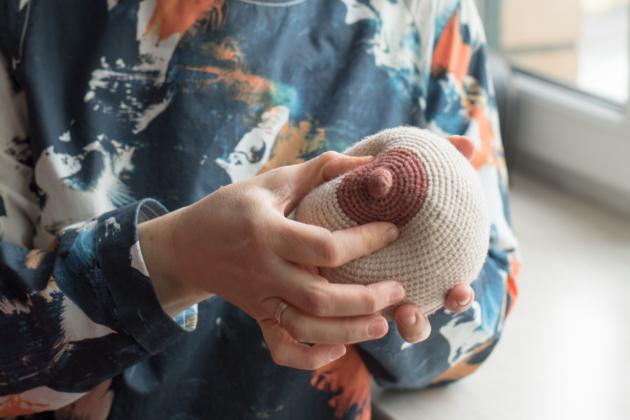Breastfeeding With Flat or Inverted Nipples
New parents have many hopes for who their baby will become and what they will accomplish in this big world of ours. But being a new parent is demanding, too—full of worries and anxieties you never knew existed before. You worry about whether they are healthy, gaining enough weight, getting the proper nutrition, and much more.
Breastfeeding is one of the best ways to ensure your baby gets the nutrition they need to survive and thrive. But sometimes, there are challenges to breastfeeding effectively. Flat or inverted nipples can make nursing difficult, making it a daunting task instead of an enjoyable one.
If you are a mother with flat or inverted nipples, don’t lose hope. There are things you can do to breastfeed more effectively.
This guide walks you through the challenges you may face while breastfeeding with flat or inverted nipples. It gives strategies for success and for dealing with soreness and other issues.
Challenges of breastfeeding with flat or inverted nipples
Roughly 10% to 20% of the female population is born with inverted nipples. An inverted nipple is retracted inwards rather than outwards. This can occur in both males and females and is either congenital or acquired. Women with this condition often find breastfeeding challenging.
Flat nipples, on the other hand, lay even, or flat, with the surrounding breast tissue instead of projecting outwards as most nipples do. While it’s a harmless condition overall, flat nipples are also a potential roadblock to breastfeeding.
When babies lap at the breast, the nipple is stretched, and surrounding breast tissue is pulled from their mouth. The stretchier or more elastic your nipple is, the easier it will be for your baby to latch.
When your nipple can’t reach the roof of your baby’s mouth, it may not stimulate their palate to trigger the sucking reflex.
Strategies for breastfeeding with flat or inverted nipples
Breastfeeding can be challenging for everyone. There are latching issues, clogged milk ducts, and pumping at work and other public places.
But just as there are strategies for increasing breast milk supply, latching, and positioning, there are also strategies for breastfeeding with flat or inverted nipples.
If you are a new mother with flat or inverted nipples, it doesn’t mean you won’t be able to breastfeed your baby. After all, providing your child with breastmilk can help protect them against various long- and short-term illnesses.
Babies breastfed by their mothers are less likely to develop obesity, asthma, type 1 diabetes, and sudden infant death syndrome (SIDS). And babies nursed by their mothers are also less likely to develop stomach bugs and ear infections.
For these reasons, moms with flat or inverted nipples are encouraged to be patient and try some unique strategies to ensure breastfeeding success.
Here are some strategies that can help:
- Wear nipple formers during pregnancy. These products are a non-invasive way to prepare inverted or flat nipples for breastfeeding after birth. For inverted nipples, wear the formers for 30 minutes daily and build up to eight hours per day once your pregnancy reaches 32 weeks. For flat nipples, follow the same approach, but wear them between breastfeeding or for at least 30 minutes before feeding your baby.
- Pinch the nipple to get it to stick out. Compress your fingers behind your nipple to make a “C” or “V” shape. This can help your baby form a better latch for a more satisfying feeding.
- Compress the breast behind the areola to help the nipple stick out. Breast compression is a highly effective way to keep your milk flowing during breastfeeding and can make the process easier for babies who can’t get the best latch.
- Use ice or a cold compress. This approach can help make your nipple firmer and erect before latching.
- Use a breast pump or hand express before feeding. Using a breast pump, or self-expressing, right before a feed can help pull out the nipple. Be sure to shape your breast before the feed, compressing your fingers just a few centimeters behind your nipple into a “C” or “V” shape.
- Use a nipple shield. These silicone devices are worn over your nipple. The nipple part has small holes at the tip, designed so that milk can flow into your baby’s mouth. The base wraps around your areola, helping the nipple to stand more erect.
- Try breast shells. Breast shells are not only helpful in protecting sore nipples, but they can also help make the nipple more erect. They provide a non-invasive way to help you nurse your baby.
- Try different positions. One of the best ways to help your baby breastfeed if you have inverted or flat nipples is to experiment with different positions. You may find that your nipple protrudes more or less in a certain posture than in another. Experiment to find a more effective and comfortable position for you and your baby.
- Breastfeed often to prevent engorgement. Breastfeeding every two to three hours is recommended to help you sustain your milk production and prevent engorgement. This is also helpful in providing your baby with a more comfortable nursing experience should you have flat or inverted nipples.
What to do if you still can’t breastfeed with flat or inverted nipples
While it may be frustrating if your inverted or flat nipples keep you from breastfeeding effectively, there are other ways to get your baby the vital nutrition they need without sacrificing the bonding experience.
You can try a supplemental nursing system, exclusively pumping, or seek out a lactation consultant for additional support.
Supplemental nursing systems utilize a container filled with supplementary milk clipped to the bra strap, pillow, or mother’s shirt. While the baby is latched, a thin tube delivers a consistent flow of milk in a controlled manner.
Pumping exclusively by hand or breast pump is also effective for mothers with inverted or flat nipples. This is often the best recommendation for parents who want their child to experience the antibodies and benefits of breastmilk when nature isn’t cooperating.
If you have tried the recommendations above and are still struggling to breastfeed, working with a lactation consultant might be an excellent next step. These individuals can help you with positioning, milk supply, and more.
How to deal with soreness of flat or inverted nipples
If you have flat or inverted nipples, the breastfeeding process is more likely to create soreness or tenderness, mainly as you and your baby get used to working together.
An estimated 90% of women experience pain when breastfeeding. So, it’s essential to keep in mind that this is normal.
Though a flat or inverted nipple condition can make the latch more challenging, there are often mitigation strategies to make it more comfortable. Your medical professional or nursing specialist can help you with different positions to reduce soreness. If your pain persists, it is best to talk to your doctor or partner with a lactation consultant.
Another approach to reducing nipple pain from breastfeeding is to soak your nipples in a saline solution three to five times per day. Mix 1/2 teaspoon of salt with one cup of warm water. Soak your nipple for a few minutes (no more than five to 10), then pat dry with a paper towel. If your baby turns away at the salt flavor lingering on your nipple, rinse with water or dab on a small amount of breastmilk.
How a lactation consultant can help with breastfeeding with flat or inverted nipples
Lactation consultants have the training and certifications to help you have a more enjoyable breastfeeding experience with your baby. Studies have shown that working with a lactation consultant can greatly increase your chances of success.
Lactation consultants are best in the following situations:
- Your milk supply is low
- Your baby is not reaching their weight milestones
- You’re struggling with finding the most productive and comfortable nursing position
- Your baby is falling asleep while nursing
- You have flat or inverted nipples, making the latch a struggle
- Your baby is refusing the breast
- You need help inducing lactation
- You are feeling drained after nursing
- You are experiencing postpartum depression, which is blocking your ability to breastfeed effectively
- You are experiencing breast pain when nursing
- You need help figuring out how to combine pumping and breastfeeding
When hiring a lactation consultant, here are some questions to ask.
- How much experience have you had with mothers with inverted or flat nipples?
- How have you handled tough breastfeeding experiences in the past?
- What is your philosophy on breastfeeding and supplementation feedings?
- What is your accessibility if I need your help?
Consider the lactation consultant’s answers to these questions to ensure you find the right one. Different lactation consultants are sometimes better for certain situations than others. You should also compare the cost of lactation consultants and see if they accept your insurance.
New parents have many hopes for who their baby will become and what they will accomplish in this big world of ours. But being a new parent is demanding, too—full of worries and anxieties you never knew existed before. You worry about whether they are healthy, gaining enough weight, getting the proper nutrition, and much more.
Breastfeeding is one of the best ways to ensure your baby gets the nutrition they need to survive and thrive. But sometimes, there are challenges to breastfeeding effectively. Flat or inverted nipples can make nursing difficult, making it a daunting task instead of an enjoyable one.
If you are a mother with flat or inverted nipples, don’t lose hope. There are things you can do to breastfeed more effectively.
This guide walks you through the challenges you may face while breastfeeding with flat or inverted nipples. It gives strategies for success and for dealing with soreness and other issues.
Challenges of breastfeeding with flat or inverted nipples
Roughly 10% to 20% of the female population is born with inverted nipples. An inverted nipple is retracted inwards rather than outwards. This can occur in both males and females and is either congenital or acquired. Women with this condition often find breastfeeding challenging.
Flat nipples, on the other hand, lay even, or flat, with the surrounding breast tissue instead of projecting outwards as most nipples do. While it’s a harmless condition overall, flat nipples are also a potential roadblock to breastfeeding.
When babies lap at the breast, the nipple is stretched, and surrounding breast tissue is pulled from their mouth. The stretchier or more elastic your nipple is, the easier it will be for your baby to latch.
When your nipple can’t reach the roof of your baby’s mouth, it may not stimulate their palate to trigger the sucking reflex.
Strategies for breastfeeding with flat or inverted nipples
Breastfeeding can be challenging for everyone. There are latching issues, clogged milk ducts, and pumping at work and other public places.
But just as there are strategies for increasing breast milk supply, latching, and positioning, there are also strategies for breastfeeding with flat or inverted nipples.
If you are a new mother with flat or inverted nipples, it doesn’t mean you won’t be able to breastfeed your baby. After all, providing your child with breastmilk can help protect them against various long- and short-term illnesses.
Babies breastfed by their mothers are less likely to develop obesity, asthma, type 1 diabetes, and sudden infant death syndrome (SIDS). And babies nursed by their mothers are also less likely to develop stomach bugs and ear infections.
For these reasons, moms with flat or inverted nipples are encouraged to be patient and try some unique strategies to ensure breastfeeding success.
Here are some strategies that can help:
- Wear nipple formers during pregnancy. These products are a non-invasive way to prepare inverted or flat nipples for breastfeeding after birth. For inverted nipples, wear the formers for 30 minutes daily and build up to eight hours per day once your pregnancy reaches 32 weeks. For flat nipples, follow the same approach, but wear them between breastfeeding or for at least 30 minutes before feeding your baby.
- Pinch the nipple to get it to stick out. Compress your fingers behind your nipple to make a “C” or “V” shape. This can help your baby form a better latch for a more satisfying feeding.
- Compress the breast behind the areola to help the nipple stick out. Breast compression is a highly effective way to keep your milk flowing during breastfeeding and can make the process easier for babies who can’t get the best latch.
- Use ice or a cold compress. This approach can help make your nipple firmer and erect before latching.
- Use a breast pump or hand express before feeding. Using a breast pump, or self-expressing, right before a feed can help pull out the nipple. Be sure to shape your breast before the feed, compressing your fingers just a few centimeters behind your nipple into a “C” or “V” shape.
- Use a nipple shield. These silicone devices are worn over your nipple. The nipple part has small holes at the tip, designed so that milk can flow into your baby’s mouth. The base wraps around your areola, helping the nipple to stand more erect.
- Try breast shells. Breast shells are not only helpful in protecting sore nipples, but they can also help make the nipple more erect. They provide a non-invasive way to help you nurse your baby.
- Try different positions. One of the best ways to help your baby breastfeed if you have inverted or flat nipples is to experiment with different positions. You may find that your nipple protrudes more or less in a certain posture than in another. Experiment to find a more effective and comfortable position for you and your baby.
- Breastfeed often to prevent engorgement. Breastfeeding every two to three hours is recommended to help you sustain your milk production and prevent engorgement. This is also helpful in providing your baby with a more comfortable nursing experience should you have flat or inverted nipples.
What to do if you still can’t breastfeed with flat or inverted nipples
While it may be frustrating if your inverted or flat nipples keep you from breastfeeding effectively, there are other ways to get your baby the vital nutrition they need without sacrificing the bonding experience.
You can try a supplemental nursing system, exclusively pumping, or seek out a lactation consultant for additional support.
Supplemental nursing systems utilize a container filled with supplementary milk clipped to the bra strap, pillow, or mother’s shirt. While the baby is latched, a thin tube delivers a consistent flow of milk in a controlled manner.
Pumping exclusively by hand or breast pump is also effective for mothers with inverted or flat nipples. This is often the best recommendation for parents who want their child to experience the antibodies and benefits of breastmilk when nature isn’t cooperating.
If you have tried the recommendations above and are still struggling to breastfeed, working with a lactation consultant might be an excellent next step. These individuals can help you with positioning, milk supply, and more.
How to deal with soreness of flat or inverted nipples
If you have flat or inverted nipples, the breastfeeding process is more likely to create soreness or tenderness, mainly as you and your baby get used to working together.
An estimated 90% of women experience pain when breastfeeding. So, it’s essential to keep in mind that this is normal.
Though a flat or inverted nipple condition can make the latch more challenging, there are often mitigation strategies to make it more comfortable. Your medical professional or nursing specialist can help you with different positions to reduce soreness. If your pain persists, it is best to talk to your doctor or partner with a lactation consultant.
Another approach to reducing nipple pain from breastfeeding is to soak your nipples in a saline solution three to five times per day. Mix 1/2 teaspoon of salt with one cup of warm water. Soak your nipple for a few minutes (no more than five to 10), then pat dry with a paper towel. If your baby turns away at the salt flavor lingering on your nipple, rinse with water or dab on a small amount of breastmilk.
How a lactation consultant can help with breastfeeding with flat or inverted nipples
Lactation consultants have the training and certifications to help you have a more enjoyable breastfeeding experience with your baby. Studies have shown that working with a lactation consultant can greatly increase your chances of success.
Lactation consultants are best in the following situations:
- Your milk supply is low
- Your baby is not reaching their weight milestones
- You’re struggling with finding the most productive and comfortable nursing position
- Your baby is falling asleep while nursing
- You have flat or inverted nipples, making the latch a struggle
- Your baby is refusing the breast
- You need help inducing lactation
- You are feeling drained after nursing
- You are experiencing postpartum depression, which is blocking your ability to breastfeed effectively
- You are experiencing breast pain when nursing
- You need help figuring out how to combine pumping and breastfeeding
When hiring a lactation consultant, here are some questions to ask.
- How much experience have you had with mothers with inverted or flat nipples?
- How have you handled tough breastfeeding experiences in the past?
- What is your philosophy on breastfeeding and supplementation feedings?
- What is your accessibility if I need your help?
Consider the lactation consultant’s answers to these questions to ensure you find the right one. Different lactation consultants are sometimes better for certain situations than others. You should also compare the cost of lactation consultants and see if they accept your insurance.
















